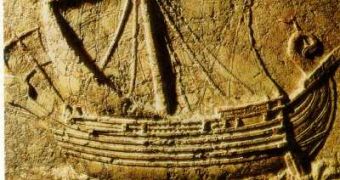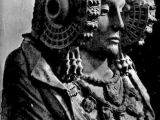When you think of marine civilizations, your mind may go to Greeks or Vikings, but actually a much older one is that of the Phoenicians. They called themselves Canaanites and their land Canaan, located along the coastal plains of what is now Lebanon and Syria. The Phoenician cities were built on the coast, in places easy to defend, like coastal islands (Tyre and Arados) or on the top of prominent promontories, like Byblos and Sidon. The most powerful Phoenician city state was Tyre, while Arados was one of the oldest known republics in the world.
Phoenician civilization was an enterprising maritime trading culture that spread across the Mediterranean between the 1200 BC and 900 BC. Their language was Semite, related to Hebrew and Arab, and so was the race of the Phoenicians. The name Phoenicians could from ancient Egyptian, meaning Syrians while some say it comes from the Greek foinix "red skin"
They were the first sailors adventuring behind the Gibraltar straits in the Atlantic Ocean and the first nation to employ man-powered trade using cedars (the famous cedars of Lebanon!)- galleys with two banks of oars (biremes), with or without sails. The cedars offered both wood and resin for building the ships and the cedar wood was extremely appreciated by the Egyptians, Jews (who made the Jerusalem Temple of cedar wood) and other people.
They usually navigated near the shore, but sometimes they adventured on the open sea, using for orientation the stars. At the beginning of their maritime expeditions, they just traded employing trading points, located close to one another, at a day of navigation on the sea one from another (about 30 km).
Herodotus counted the way Phoenicians traded with the Indigenous people of the shores they reached:
"Once arrived, they discharged their merchandise on the shore, exposed in order, made a fire and after that they returned to their ships. The locals saw the smoke, and approached to the place, leaving behind the gold amount they offered for the merchandise and retreated ...".
When the Phoenicians considered that the barter was fair, they accepted the offer, if not, they waited on their ships till the local population completed the right sum. This type of trade occurred especially on the African coasts of the Atlantic, inhabited by more primitive tribes. Later, the changes involved coins.
The Phoenician merchandise included highly desired purple fabrics (which they made it using a dye extracted from the marine snail Murex, their trademark, that's why Phoenicians were also named "Purple People"; ), wool, small adornments (amulets, painted ostrich eggshells, and others), glass dishes (Phoenicians are the discoverers of the transparent glass), perfumes, iron weapons, cedar wood (for making ships), ivory objects (carvings, combs, toiletries), peacock (extremely expensive) and ostrich (cheaper) feathers and required wheat, wine, oil, gold, tin, lead, silver, copper (for making bronze) and even slaves. (It's worth noting that the purple fabrics were signs of royal or noble rank in the antiquity.)
Phoenicians detained the monopoly on the ivory trade in the Mediterranean. The material came from remote areas of Black Africa, passing through the hands of many intermediaries and was always expensive. Ivory from Sudan passed through the hands of Egyptian intermediaries, while some bold Phoenician sailors reached the coast of the Gulf of Guinea to get the material. No wonder, this was a luxury product. Phoenician ivory carvings depicting gods or animals were sought for in Syria, Palestine, Egypt and Cyprus. Ostrich feathers were obtained from Nubia, located south of Egypt, while Phoenicians grew peacocks brought from India.
The Phoenician art was extremely multicolored and stuffy and was influenced by the Egyptian and Cypriot art, like bowls mimicking leopard heads, heavily decorated pitchers with animals and flower motifs, or multicolor glass recipients. Phoenicians were the discoverers of the glass, and made of it dishes, collar balls, pendants, earrings and trinkets. Houses were decorated with wall paintings in vivid hues, reproducing very complicated and capricious ornamental motifs. Nobles used to be buried in Egyptian stone cut sarcophaguses. Traders wore caps.
Metallurgy was developed, as due to their trade the Phoenicians got a lot of raw material: copper from Cyprus, Negev desert, Iberian peninsula and British islands while tin, gold and silver from Africa and Arabia. The melting of the metals was made in enormous factories, and the ingots kept in secret stores. The metals were processed into weapons, glasses and jewels. Bronze smiths of Tyre made the sacred dishes of the Jerusalem temple and the goldsmiths of Sidon are said to have made a magnificent decorated silver urn offered by Achilles as recompense for the conquest of Troy.
In the Byble, Jews presented the Phoenician women as having dissolute habits and practicing repugnant acts imposed by their religion. They were also presented as living in opulence and luxury.
In the centuries following 1200 BC, the Phoenicians formed the major naval and trading power of the Mediterranean. Their rise is attributed to the collapse of the Minoan and Mycenean civilizations in the Aegean Sea, and the Phoenicians took possession of ther markets in Egypt, Cyprus and Asia Minor; still the Phoenicians went further, opening factories in the North Africa, Iberian peninsula and islands of the western Mediterranean. The factories did not have military character; they were permanent or provisional, almost always placed in isolated places, easy to defend, where the Phoenicians made their interchanges with the locals.
Beginning with the XI-Xth centuries BC, the Phoenicians started colonizing the Mediterranean, founding cities in Sicily, Sardine, Balearic Islands, Cyprus, Corsica, Malta, southern Spain, Portugal and northern Africa till much away from Gibraltar, in modern Mauretania.
Some scholars think that the name Spain comes from the Phoenician word I-Shaphan, meaning "island of rabbits". No doubt, their most powerful colony was Carthage, in northern Africa, in today Tunis, founded in 814 BC by Pygmalion of Tyre. Others say the city was founded by Pygmalion's sister, Elissa, after her husband Acerbas was assassinated.
Carthage turned into a maritime power, which made trade in a different manner from Phoenicians. Ships carried soldiers, and the appealing territories were conquered by force or achieved willingly. The colony largely exceeded its metropolis, being a constant menace for the newly emerging Roman power till its complete destruction in 146 BC. (remember the Carthage's general Hannibal?).
In the X century BC, sent by the king of Tyre, Hiram I, and by Solomon, the king of Israel, Phoenician ships went to the city of Ophir, still not precisely determined, but possibly in the southeastern India. The ships returned with "gold, silver, ivory, peacocks" and many other treasures, as wrote in the Book of the Kings.
But as Strabon, the Greek historian, revealed, the Phoenicians kept in extreme secret their expeditions; that's why it's hard now to track them.
Herodotus mentions a story that indicates us the Phoenicians to be the first explorers that got around Africa in about 600 BC, 25 centuries before the Portuguese Vasco Da Gama, at the order of the Egyptian pharaoh Necho II (609-593 BC), starting from the Red Sea and returning through the Gibraltar Strait after three years.
Carthage funded many expeditions on the sea, and Punic ships (Pun was the other name of the city) reached in the V century BC the British islands. They describe the Albion Island, rich in tin and lead.
More documented is the journey of Hanno the Navigator, around 425 BC. His expedition was made of 60 ships and he navigated along the western coast of Africa till the Gulf of Guinea, describing hippopotamuses, crocodiles and gorillas, which they thought they were primitive people.
They reached even the Azores Islands (Madeira and Canary were already known to the Phoenicians). But the biggest puzzle is: did they reach America?
Diodorus Siculus wrote in the first century BC that "west of Libya (Africa), there is a large island on the ocean. Its shores are covered by dense forests and there are a lot of springs. The plains are vast and crossed by many navigable rivers".
The Phoenicians could have reached America by chance, caught by a storm off northwest Africa. Many identify this description and other of Greek and Roman authors to South America, Antilles or the Mexican coasts.
Phoenician ships were famous for their resistance to sea storms, and the Phoenician fleet was involved in many military campaigns, as part of alliances made by the Phoenician kings or as mercenaries (Egyptians used many times the Phoenician fleet for this purpose). But later, Phoenician cities were overwhelmed by the invasions of foreign powers: Assyria, Babylon, Persia, the Greeks of Alexander the Great, Roman Empire and vanished from history. A Phoenician fleet was involved in the Persian disaster of Salamis (480 BC), when the Greeks achieved a huge victory on the sea.
In what were once areas of Phoenician settlements, certain inhabitants still consider themselves descendants of Phoenicians. This includes some Lebanese, Syrians, Maltese, Tunisians, Algerians, Spaniards, Portuguese and a small percentage of Somalis, along with certain other island folks in the Mediterranean.
Around 1200 BC, the Phoenician alphabet emerged and all other European (Latin, Greek) and Middle East and Indian alphabets derived from this one. This is the first alphabet in the world, a writing in which signs encode sounds, not syllables. The Phoenicians exerted considerable influence on the other groups around the Mediterranean, notably the Greeks, who later became their main commercial rivals. Even the word "Bible" comes from the name of the Phoenician city Byblos, a source of papyruses.

 14 DAY TRIAL //
14 DAY TRIAL // 

